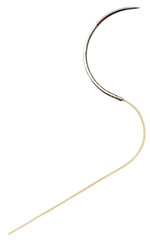- 1-0 Sutures
- 10-0 Sutures
- 2-0 Sutures
- 3-0 Sutures
- 4-0 Sutures
- 5-0 Sutures
- 6-0 Sutures
- 7-0 Sutures
- 8-0 Sutures
- Absorbable Sutures
- Aesculap Sutures
- Antibacterial Sutures
- Biosyn Sutures
- Black Sutures
- Blue Sutures
- Braided Sutures
- Caprosyn Sutures
- Cardinal Health Sutures
- Chromic Gut Sutures
- Clear Sutures
- Covidien Sutures
- CP Medical Sutures
- Dafilon Sutures
- Dermalon Sutures
- Deroyal Sutures
- Dissolvable Sutures
- Ethibond Sutures
- Ethicon Sutures
- Ethilon Sutures
- Gut Sutures
- Look Sutures
- Maxon Sutures
- Medical Action Industries Sutures
- Medline Sutures
- Mersilene Sutures
- Monocryl Sutures
- Monoderm Sutures
- Monofilament Sutures
- Monosof Sutures
- Novafil Sutures
- Nurolon Sutures
- Nylon Sutures
- PDS Sutures
- PGA Sutures
- Polybutester Sutures
- Polydek Sutures
- Polyester Sutures
- Polyglycolic Sutures
- Polymer Sutures
- Polypropylene Sutures
- Polysorb Sutures
- Polysyn Sutures
- Prolene Sutures
- Rapide Sutures
- Silk Sutures
- Sofsilk Sutures
- Spiral Sutures
- Steel Sutures
- Supramid Sutures
- Surgical Specialties Sutures
- Surgical Sutures
- Surgilon Sutures
- Surgipro Sutures
- Suture Removal Kits
- Suture Scissors
- Suture Trays
- Synthetic Sutures
- Teleflex Sutures
- Tevdek Sutures
- Ticron Sutures
- Undyed Sutures
- Vicryl Sutures
- Violet Sutures

Hospitals, ERs and medical offices all use sutures to repair lacerations and incisions. Some types of sutures absorb into the skin during the healing process, eliminating the need for later removal. Find out more about absorbable sutures and absorbable suture sizes below.
What is an Absorbable Suture?
An absorbable suture dissolves as a wound heals. By the second or third week of healing, the tensile strength of an absorbable suture begins breaking down. Within three months, the skin has completely absorbed the stitches.

Covidien #SC5626, SUTURE, CAPROSYN, ABSORBABLE, 5/0, 18, P-11, 36/BX
$736.26 per BOX

Aesculap #C0069620, SUTURE NOVOSYN ABSORB UD
$215.09 per BOX

Covidien #VLOCM2245, SUTURE, VLOC, ABSORBABLE, 2-0, GS22, NEEDLE, 12/BX
$517.48 per BOX

Covidien #GC124, SUTURE, ABSORB, CAPROSYN, 0, UNDYED, 30", V-20, 36/BX
$394.75 per BOX

Covidien #SC5627G, SUTURE, CAPROSYN, ABSORB, 4-0, VL, 18, P-12, 12/BX
$175.06 per BOX

Covidien #GC323, SUTURE, ABSORB, CAPROSYN, 2/0, VL, 30", V-20, 36/BX
$411.91 per BOX

Surgical Specialties #MA-490N, SUTURE, 5-0 POLYSYN DSMII, FAST ABSORBING, 12/CS
$75.80 per CASE

Surgical Specialties #M490N, SUTURE, 5-0 POLYSYN DSMII, FAST ABSORBING, 12/BX
$76.60 per BOX

Covidien #SV2298, Suture, Absorbable, Size 3-0, 30", Undyed, C-13 Needle, 36/bx
$449.70 per BOX
How Does an Absorbable Suture Work?
Physicians typically stitch internal wounds with an absorbable suture, and then use a non-absorbable suture for exterior applications. When the absorbable sutures are internal, the patient’s immune system acts against what it perceives as a threat. The enzymes that naturally occur in the tissues break down the fibers of absorbable sutures. Many types of absorbable sutures are quite strong at first, but they degrade quickly along a similar time frame as the healing process.
Absorbable Suture Types
Absorbable sutures can be monofilament or a braided multifilament material. They can be made from natural fiber or synthetics. The four most common absorbable suture types are as follows:
- Gut – Gut sutures come from natural materials and are single-stranded. Their most common use is in gynecological surgery such as Caesarean sections.
- Poliglecaprone (MONOCRYL) – Poliglecaprone sutures are single synthetic filaments. Surgeons mainly use these types of absorbable suture for repairing soft tissues and minimizing scarring.
- Polyglactin (Vicryl) – A braided multifilament material made from synthetics, the polyglactin absorbable suture is a frequent choice for hand or facial repairs.
- Polydioxanone (PDS) – Monofilament PDS sutures are made from polydioxanone, a synthetic material. These types of absorbable suture are frequently used in abdominal surgery and pediatric cardiac surgery.
Absorbable Suture Sizes
The United States Pharmacopoeia designates suture sizes according to the diameter of the strand. For example, a size 5 USP synthetic absorbable suture is 0.7 millimeters in diameter. At the other end of the scale, a size 10-0 USP is 0.02 mm in diameter, so the smaller, single digit sizes of absorbable sutures are the largest in diameter.
The most common absorbable suture sizes and their uses include:
- Sizes 3-0 to 4-0, 0.2 mm and 0.15 – general repair
- Sizes 5-0 to 6-0, 0.1 mm and 0.07 mm – facial repair
Non-absorbable Sutures
Non-absorbable sutures do not degrade, so patients must return to their healthcare providers to have these stitches removed. They are made from natural materials like silk and synthetics like polyester, nylon and polypropylene. Sometimes, physicians even use wire sutures when the job calls for extra strength, such as some types of orthopedic surgery.
Absorbable Suture Suppliers
When you need absorbable suture suppliers with the material, size and price options your practice needs, look no further than CIA Medical. With over 5,000 brands and 500,000 products in our catalog, you won’t find a better selection anywhere.
CIA Medical Stocks Absorbable Sutures With Great Bulk Pricing for Medical Pros
We offer extensive options in brands, types and sizes of medical supplies, and if you don’t see what you need in our online catalog, get in touch and we help you find it. We provide quick quotes and white-glove service too. Create your CIA Medical account today, or call us at (312) 275-5850 for more information.
When the sutures are internal, the patient’s immune system acts against what it perceives as a threat. The enzymes that naturally occur in the tissues break down the fibers of absorbable sutures. Many types of absorbable sutures are quite strong at first, but they degrade quickly along a similar time frame as the healing process.

